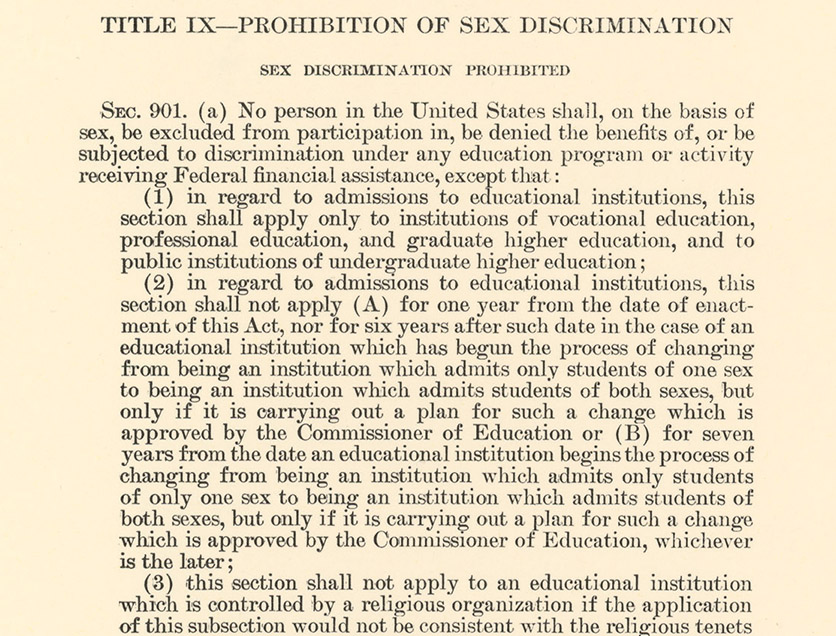
National Archives Museum Displays Title IX Documents Ahead of All American Sports Exhibit
By Angela Tudico | National Archives News
 WASHINGTON, August 31, 2022 — Title IX fundamentally changed the face of American sports, providing girls and women with greatly expanded opportunities to compete. Part of the Education Amendments Act of 1972, Title IX prohibits sex-based discrimination in education programs and activities that receive federal funding. According to the Women's Sports Foundation, this measure exponentially increased the proportion of girls and women who play sports in the United States, from about 3 percent before its passage to 40 percent today.
WASHINGTON, August 31, 2022 — Title IX fundamentally changed the face of American sports, providing girls and women with greatly expanded opportunities to compete. Part of the Education Amendments Act of 1972, Title IX prohibits sex-based discrimination in education programs and activities that receive federal funding. According to the Women's Sports Foundation, this measure exponentially increased the proportion of girls and women who play sports in the United States, from about 3 percent before its passage to 40 percent today.
To commemorate half a century of the civil rights law, documents relating to the legislation are on view in the Featured Document Display: The 50th Anniversary of Title IX. The exhibit will be open through September 7 in the West Rotunda Gallery at the National Archives Museum in Washington, DC. It also serves as a preview of the new exhibit opening on September 16, All American: The Power of Sports, which will run through January 7, 2024, in the Lawrence F. O’Brien Gallery of the National Archives Museum.
Title IX and related documents will be on display as part of the exhibit when All American opens September 16.
Some of the objects in “The Power to Break Barriers” section of the All American exhibit will show the impact of Title IX on women in sports in a way that numbers alone cannot.
“The landmark Title IX act is on display, along with artifacts from champion women's sports teams who celebrated victories at the White House,” said Exhibit Curator Alice Kamps. “Without the opportunities to hone their sport at the college level, which Title IX made possible, many professional women's sports teams might not exist today.”
The Presidential gifts on display include an autographed basketball from the 2012 Women’s National Basketball Association championship team, the Indiana Fever, and a 2015 U.S. Women's National Soccer Team jersey given to President Barack Obama.
While these artifacts reflect success on a championship level, they also show how Title IX increased access to team sports for girls and women across the country, and they stand in contrast to women’s individual athletic achievements before passage of Title IX, which are also highlighted in the All American exhibit.
The triumphs of tennis champion Althea Gibson, Olympic sprinter Wilma Rudolph, and marathon runner Kathrine Switzer are all featured and show the challenges female athletes faced before the passage of Title IX. Gibson shattered class and racial barriers when she worked to integrate national and international tennis and went on to become the first Black woman to win a Grand Slam tennis tournament in 1956. Although Rudolph was the youngest U.S. Olympian that same year and then won three gold medals at the Rome Olympics in 1960, her athletic success did not necessarily translate to economic opportunities at home. For Switzer, the challenge and the triumph were one in the same—participating at all.
“It's kind of shocking to realize that in 1967, when Kathrine Switzer became the first officially registered woman to run the Boston Marathon, most people didn't believe women were capable of completing one,” Kamps said. “Not only that, but she was violently assaulted by a race official for daring to try to compete against men. That was the landscape before Title IX. When you look at the opportunities and respect for women athletes today, you realize Title IX was a game changer.”
Read more about the 50th anniversary of Title IX and watch clips of Gibson, Rudolph, and Switzer in the National Archives’ The Unwritten Record blog, “Celebrate the 50th Anniversary of Title IX with Archival Footage of Sporting Legends.”
All American: The Power of Sports is made possible in part by the National Archives Foundation through the generous support of AT&T, AARP, and Mars, Incorporated. Additional support provided by HISTORY® and the Lawrence F. O’Brien Family.

